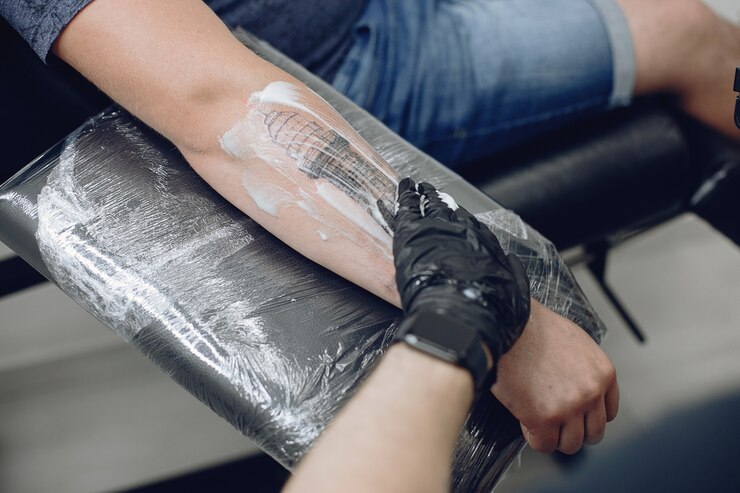Tattoos are a great way to express yourself, but they can also be painful. You may have heard about tattoo numbing cream, but you might not know what it is or how it works. The numbing cream is a topical anesthetic that you can use before getting your tattoo to reduce the pain and discomfort. It works by blocking the nerve impulses in the skin, which prevents messages from going to your brain. This article will explain everything you need to know about this product and whether or not it’s worth trying.
A Quick Background On Tattooing
Tattooing is a form of body modification and has been practiced for thousands of years. The process involves using a needle to puncture the skin and deposit ink into the dermis layer of your skin. While tattooing was once considered taboo and often associated with gang members, it’s now an accepted part of society—especially in Western countries where many people like to get tattoos as symbols of their individuality and self-expression.
Tattoos are permanent because they cannot be washed off or easily removed by laser treatments (although you could try ripping them out). However, you can cover up an old one by getting another tattoo over it! This can lead to interesting mixed-media designs; just ask any fan of Johnny Depp’s head tattoos if they look good together…
The Science Behind Tattoo Pain
Tattoos are made by injecting ink beneath the skin. The needles used to carry out this process are extremely sharp, which means that they can pierce the skin and inject ink into it. This process of piercing and injecting is what causes most people to feel pain while getting a tattoo.
You may have heard that the pain you experience when getting a tattoo comes from how deep or shallow the artist goes each time s/he makes an incision in your skin with a needle. While this might be true for some people, others report feeling only mild discomfort during their tattoo sessions—even at times when it looks like their artist is going deep enough to puncture bone!
So, why do some people feel more pain than others? The answer is simple: because they have different levels of pain tolerance. Some people are able to withstand more intense sensations before they become uncomfortable, while others react strongly even when faced with mild discomfort.
How Does A Numbing Cream Work?
There are two main types of numbing creams:
- Topical anesthetic creams, which contain a local anesthetic such as lidocaine or prilocaine. These products work by temporarily blocking nerve signals from reaching the brain. They can be applied before you get your tattoo or during the process to numb specific areas of skin. These creams don’t reduce swelling or bleeding, but they will help prevent some pain associated with getting a new tattoo.
- Transdermal analgesic gels and sprays, which deliver a small amount of medication into your bloodstream through the skin’s surface. This type of product is similar to taking pills orally—they contain drugs like lidocaine or benzocaine (also known as cocaine). Transdermal analgesics may cause drowsiness and dizziness in some people; they’re also not recommended for use while pregnant because they’re absorbed into your system more quickly than traditional topical anesthetics do
If you’re interested in using tattoo numbing cream for your tattoo, talk to your artist first. He or she may have specific recommendations about which type of product is best and how much time should elapse between application and the start of the tattoo process.
The Best Way To Avoid Tattoos Becoming Irritating
The best way to avoid tattoos becoming irritating is to make sure that you’re getting your ink done by a professional. Tattoo artists should be licensed and their studios should be clean and hygienic. If you’re not sure about the tattoo artist’s credentials, ask for recommendations from friends or do some research online (you should probably steer clear of any shops that have less than 4 stars on Yelp).
When you go in for your appointment, make sure that the artist wears gloves and uses sterile needles—if there are other customers in the shop, wait until everyone else has left before getting started on your own piece so as not to pass along any bacteria or germs from previous clients.
You should also make sure that you’re hydrating well before and after getting your tattoo, as well as during the process. Tattooing can cause mild to moderate dehydration, so drinking plenty of water before and after your appointment will help keep your skin looking its best.
In Short, Numbing Cream Can Make Your Next Tattoo More Comfortable, With Less Pain And Irritation
The best numbing cream is one that works for you. If the product doesn’t work, there’s no point in using it. Besides, every person’s skin reacts differently to various ingredients in topical creams and lotions.
The best numbing cream is one that you can apply without any complications. You don’t want to be distracted by how much time it takes for your numbness to kick in or how long it lasts—you just want an easy solution that gets the job done efficiently and effectively so you can move on from this experience as quickly as possible!
The best numbing cream is one that has a long-lasting effect. It would be nice if this product could numb pain entirely during the entire process but we know that isn’t possible yet; however, if we do have some measure of relief during our appointments then why not take advantage of it?
Tattoos are a great way to express yourself and show your personality. But they can be painful, especially when you get them done in areas where there are high concentrations of nerves such as the inner forearm or lower back. Why? Because it takes longer for the numbing cream to work on these parts of your body due to their proximity with major blood vessels that supply oxygen and nutrients through capillaries around the area being tattooed which makes the process much more painful. You may check it here for the best numbing cream available online in the UK.
Read Also: Before You Stretch: Key Things to Consider Before Using ear stretching kits
















Leave a Reply